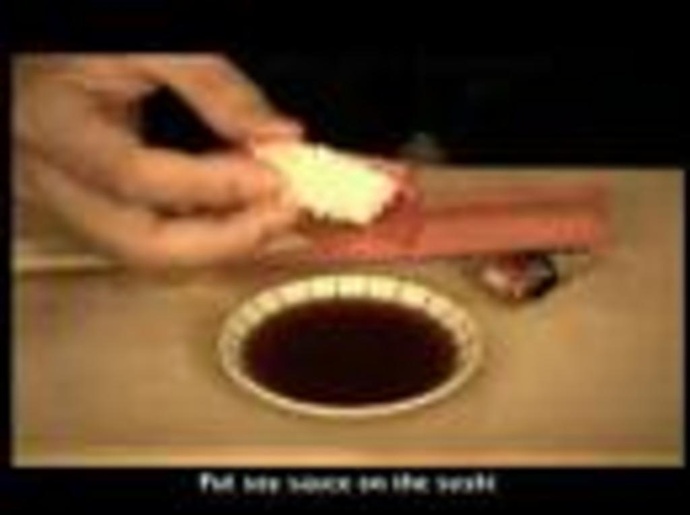
|
||
 Enlarge
Enlarge
|
Licensing | |
http://youtube.com/watch?v=pIb6ZSqal64
This video would likely be called racist if produced by an American or European, but its producers are Japanese comedians. The video reappropriates Western Japanophilia. It takes a popular Japanese product, sushi, that, while exceptionally Westernized in renditions such as California rolls, is still taken by many Westerners to represent authentic Japanese culture, and explains the etiquette around sushi consumption in a Japanese context. The video imitates the way Western documentaries focus on every little detail of the experience, from the way one enters the establishment to the way one takes a seat and orders. It particularly makes fun of the way Westerners exoticize Japanese etiquette: the actors make exaggerated bows to each other, phrases are repeated excessive numbers of times, and little graphs are repeatedly used to show exactly how to position one’s hands or head. The video also references Western fixation with samurai culture by positing the practice of women pouring beer for men as “the Samurai way.”
In watching this video, a Westerner is confronted with the fact that many Western depictions of Japanese culture are exceptionally exoticizing and often try to read too much into cultural nuances. For example, in one scene, the narrator explains how one is supposed to hold up a different number of fingers to show how many people are in the party. This explanation clearly shows the Western viewer that some actions do operate across cultural boundaries and that Western focus on etiquette can be excessive. In another scene, the narrator explains that, upon exiting the restaurant, one is supposed to eat extra salt from the bowl next to the door. While few Westerners probably believe this to be accurate, this scene confronts the Western viewer with the possibility that some of his or her other assumptions about Japanese culture may be this absurd.
On the other hand, a Japanese viewer is faced with the possibility that Japanese self-exoticization contributes to Western exoticization of Japan. In the scene with the salt bowl outside the door, the Japanese viewer is forced to realize that, while to him or her, the salt bowl’s use is obvious, it is not obvious to foreigners. The idea that the salt is there to be eaten is absurd even to the Western viewer, but it confronts the Japanese viewer with the question as to why outsiders might think such absurd things about his or her culture. Also, the exaggerated bowing and excessive attention to detail, while humorous, also subtly questions the Japanese viewer about how he or she as a Japanese, as well as Japanese society as a whole, presents itself through media and politics.

This work is licensed under a Creative Commons Attribution-No Derivative Works 2.5 License
 jdecker
—
Last modified Mar 30 2011 8:01 p.m.
jdecker
—
Last modified Mar 30 2011 8:01 p.m.
Part of these albums

|
Japanophilia mpitelka
mpitelka
|

|

 James Irvine Garden
James Irvine Garden
 Journal feed
Journal feed
